Power up Your Pelvis
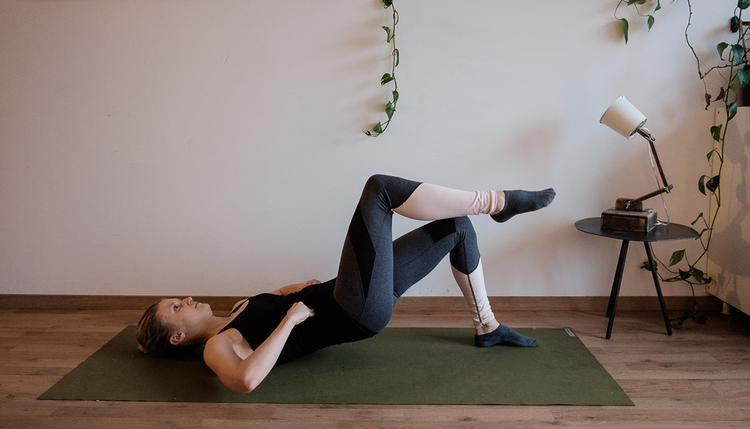
Use this routine to strengthen your pelvic and hip muscles.
It’s easy to forget how connected our body and movements are to our emotions and feelings. Though we tend to distinguish between the body and mind, in reality, there is no distinction.
How we feel and our physical health are inextricably related. Think about it for just a minute and you realize this right away. When you are in pain or feel ill, of course you won’t feel happy and joyful! And conversely, when you are going through some difficult emotional times, you’ll have less energy and your body will seem unwilling to move.
These examples show that, while this is true in general, there are also very specific relationships between your physical abilities and emotions, which we’ll discuss in greater detail below.
Pelvic girdle fitness
This may be a relatively uncomfortable and embarrassing dinner table conversation, but it is essential in talking about love, sex and reproductive health. The fitness of our pelvic girdle (pelvis/hip joints and muscles), in terms of strength, flexibility and control, bear a direct relationship to how we physically express love and affection.
This is not just in the physical act of sex, but also in how open we are in expressing ourselves. There’s a lot to being confident in our physical abilities, particularly in how well we can move our hips and pelvis. Sensations of weakness and inflexibility lead to being withdrawn and hesitant about sharing ourselves and opening up to partners.
Feeling strong and able in this area is incredibly important for satisfying and healthy emotional and physical relationships with our significant others.
Foundation: kegels and bracing
Let’s begin with the pelvic floor, as it’s the foundation of pelvic health and should remain a focus throughout the movements we’ll share in this article.
Kegels
You’ve likely heard of kegels before. They are a pelvic floor muscle exercise wherein you contract and hold the muscles for a period of time to help gain strength and control over them. Popularly prescribed for women after childbirth, the standard cueing is to “squeeze your muscles as if you are preventing yourself from urinating.” Though they are used in particular for issues of weakness following giving birth and for incontinence, improving strength and control here does more than just that. Developing your physical capacity here can directly relate to sexual health as well.
Begin by lying on the floor with your knees bent comfortably and practice “squeezing” and “pulling up” your pelvic floor for a few seconds at a time. You’ll want to work up to 15 second holds at a moderate contraction. And let’s emphasize the moderate contraction! Imagine making a fist as hard as you can, then letting off about 50 to 60 percent—this is what you should be feeling when practicing this exercise. Doing 10 repetitions of 10 to 15 second holds throughout the day will provide a lot of benefits.
As you become comfortable with kegels, this next part involves incorporating the kegels into core work. In this way it will become more of a habit in your other physical training as well. There’s a deep connection between the pelvic floor and your abdominal and back strength.
Bracing
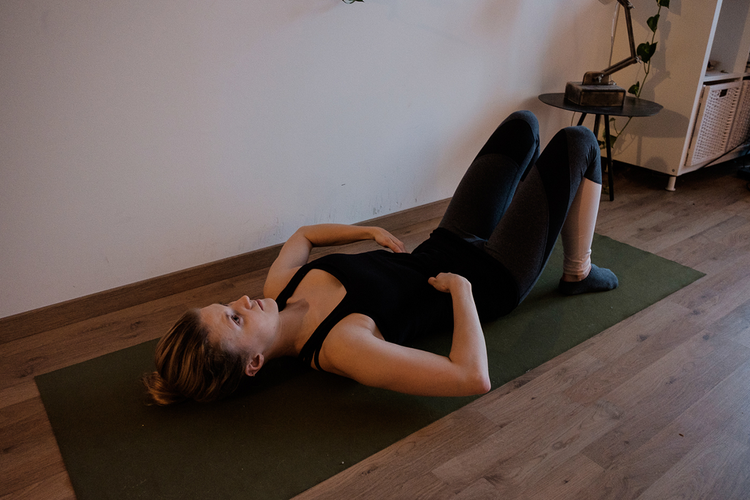
In the picture above, Alicia is placing her fingers on the sides of her stomach to help her perform this move correctly. As you do your kegel contraction, you’ll want to brace and push your abdomen outward into your fingers. (Imagine someone is going to punch you in the stomach and you are bracing for the impact.) Again, this should be a moderate contraction, and simply give you a feeling of stability throughout your core.
Practice this for the same 10 repetitions of 10 to 15 second holds. This exercise carries over to the pelvic health routine we will share below, as it should be done throughout your performance of the moves.
Pelvic health routine
https://www.youtube.com/watch?v=nujbW3Ow7Cg
This routine will give you a great start for improving your pelvic girdle strength, flexibility and control. Remember to incorporate the kegel and bracing you just learned above into each exercise.
Shoulder bridge
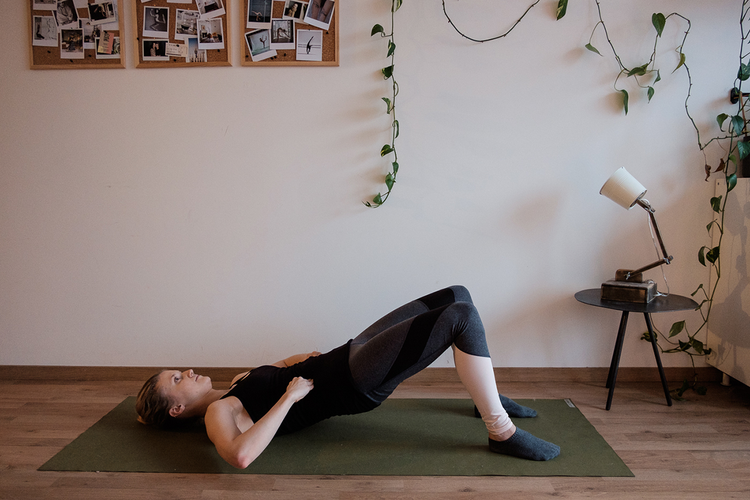
Let’s start with the shoulder bridge which integrates gluteal, hamstring, abdominal strengthening and control all at once.
- Begin by lying on your back with your knees bent and feet flat on the floor about hip width apart.
- Start with the kegel and bracing, then lift your hips up by squeezing your glutes.
- Control your positioning by making sure your hips are even throughout the lift and the hold at the top.
- Hold for 10 seconds, then drop down and fully relax before you begin the next repetition. Repeat for six repetitions.
Hip rotator stretch
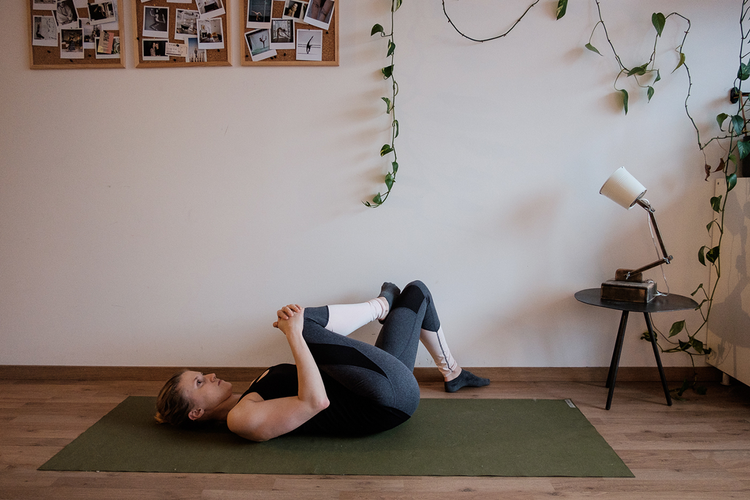
Next is the hip rotator stretch.
- In the same position as the shoulder bridge, you’ll now cross one leg over the other and bring your hips further to one side (the side opposite the leg you crossed over).
- Pull your knee towards your opposite shoulder.
- This should not be a painful stretch, but one that you should feel loosen up as you hold.
- Hold for 15 to 30 seconds. Repeat on both sides three times.
Single leg bridge
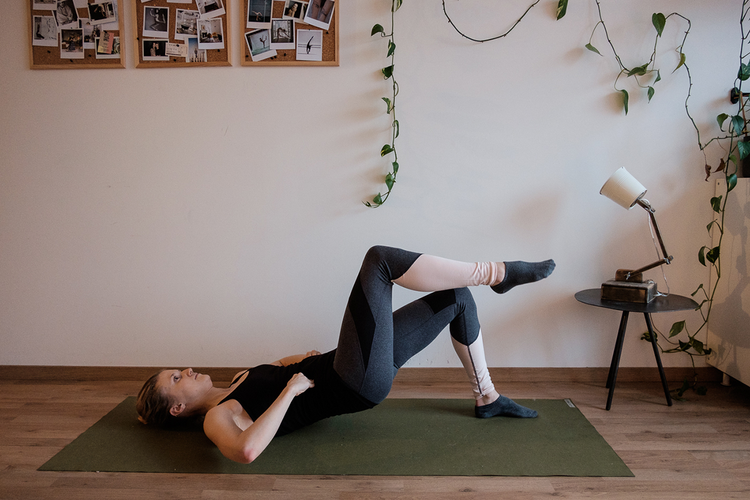
The next movement is a progression from the shoulder bridge. This time you’ll lift up on one leg while the other foot is up in the air.
- Again, begin with the kegel and bracing, lift one knee up in the air and then push with the grounded heel to raise your hips.
- It is especially important here to keep your hips level (horizontally).
- Work up to a 10-second hold, and then drop down to relax before switching to the other leg. Repeat on both sides for three repetitions.
Kneeling lunge stretch
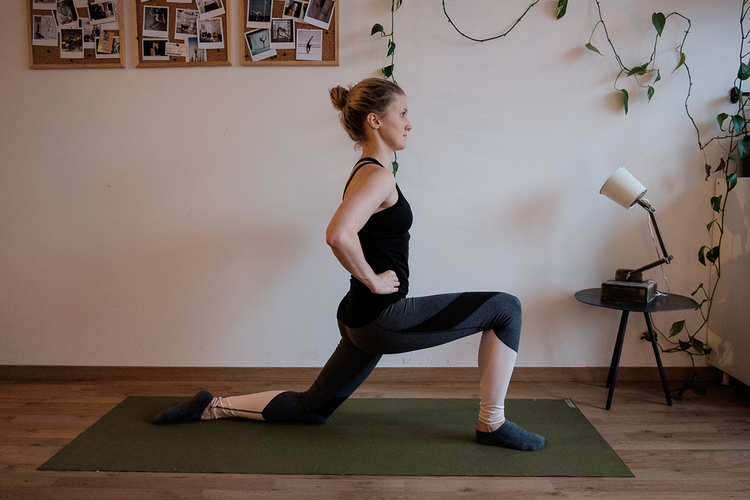
Now move on to a kneeling lunge stretch, which stretches your hip flexors, while working on pelvic control.
- Position yourself so one foot is forward and the other knee is on the ground.
- Your stance should be wide enough that you feel stable, so bring your front leg outward as much as you need to. Also, give yourself some room to move by making sure your front foot is far enough in front of you that you can bend your knee forward comfortably.
- Keep your pelvis tucked in (think about squeezing your glutes), and practice the kegel and bracing as you rock forward to stretch and hold for 15 to 30 seconds.
- You’ll notice Alicia moves in and out of the position a few times to find what will be best for her. Repeat on both sides for three repetitions.
Squat
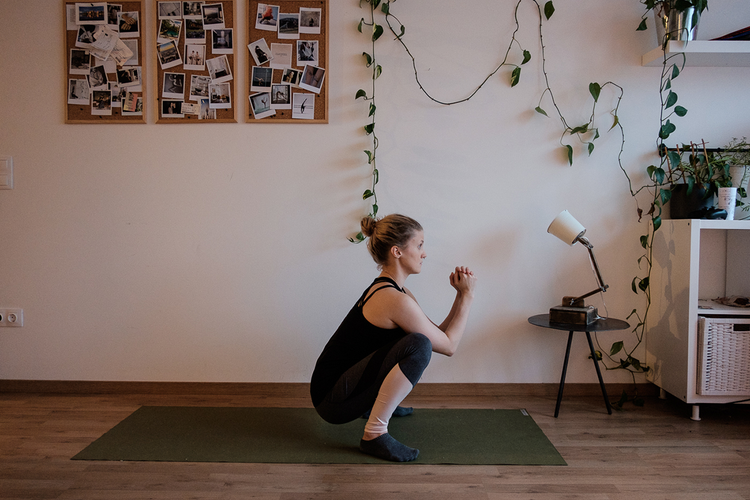
Next in the sequence is the classic squat.
- Place your feet shoulder-width apart, and experiment with how much your toes point out for comfort.
- Keep your chest up tall and drop your hips straight down between your legs as low as you are comfortable.
- As always, remember the kegels and bracing. Do 10 repetitions.
Frog stretch
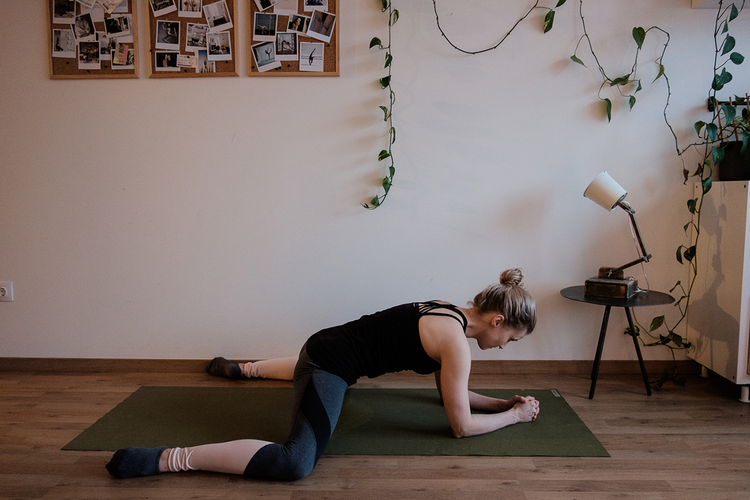
This move we call the frog stretch and it’s an excellent stretch for the hip adductors.
- Kneel down and bring your knees apart until you feel a stretch in your inner thighs.
- The trick is not to rock your hips too far backward (if you do, you may feel a pinch in the front and sides of your hip).
- Kegel and brace and flatten your back by tucking your pelvis (squeeze your glutes), then rock back and position yourself into the stretch.
- It can be helpful to rock back and forth a few times, as Alicia shows in the video, to position yourself as best you can.
- Hold for 30 seconds, and repeat three times.
How to use this routine
Perform all of these movements in a row and you’ll have done a nice round of work for improving your pelvic physical capacity. I suggest one round through the movements daily, until you feel comfortable with performing them, and then work up to three to five rounds with a couple of minutes’ rest in between. This can be a nice standalone routine or performed as a nice warm-up or cool-down in your regular training sessions.
Being strong and mobile in our pelvis and hips provides confidence and a capacity for being open and assured in our relationships with our significant others, not just physically, but emotionally as well. Spend time working on your pelvic health and you’ll be happier for it!
Photo and video credit: Courtesy of GMB Fitness